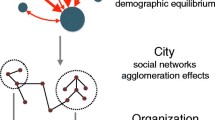Abstract
Q mode factor analysis is used to isolate the latent structure of the pattern of telephone calls between Montana towns. An eleven axis component solution accounts for 82.6% of the variance of data set and defines a series of nodal regions in the state. A higher order factor analysis is used to generalize these results into second and third order levels of connectivity. Comparison of the first order regions with results derived from Huff's gravity model demonstrates the utility of this theoretical formulation. The overall spatial structure of connectivity bears close relationships with the hierarchical and reciprocal propositions about urban structure formulated by Friedmann but there are a lot of overlapping connections and local distortions which modify the pattern.
Similar content being viewed by others
References
Black, W. R. (1973), “Toward a Factorial Ecology of Flows.”Economic Geography, vol. 49, pp. 59–67.
Brown, L. and Holmes, J. “The Delimitation of Functional Regions,”Journal of Regional Science, 1 (1971), pp. 57–72.
Cattell, R. B. (1968), “Higher Order Factor Structures,” in C. Banks and P. L. Broadhurst (eds.),Studies in Psychology: Essays Presented to to Cyril Burt, London.
Clark, D. (1973a), “Normality, Transformation and the Principal Component Solution.”Area, Vol. 5 (2), p. 110–113.
Clark, D. (1973b), “The Formal and Functional Structure of Wales,”Annals Assoc. of Am. Geographers, 63, pp. 221–38.
Christaller, W. W. (1932), Translated C. Baskin, 1964),Central Places in S. Germany. Prentice Hall.
Davies, W. K. D. and Barrow, G. (1973), “A Comparative Factorial Ecology of Three Canadian Cities,”Canadian Geographer, 17 (4), pp. 327–357.
Davies, W. K. D. and Lewis, C. R. (1970), “Regional Structure in Wales,” Chapter 2 inUrban Essays: Studies in the Geography of Wales, Longmans, U.K.
Davies, W. K. D. and Musson, T. (1978), Spatial Pattern of Commuting in South Wales, 1951–71."Regional Studies, No. 12, pp. 353–366.
Davies, W. K. D. and Robinson, G. W. S. (1969), “The Nodal Structure of the Solent Region.”Journal, Town Planning Institute, Vol. 54, pp. 18–23.
Davies, W. K. D. (1972), “Conurbation and City Region in an Administrative Borderland.”Regional Studies, No. 6, pp. 217–236.
Davies, W. K. D. (1978), “Alternative Factorial Methods and Urban Social Structure,”Canadian Geographer, No. 22, 4, pp. 273–297.
Dunn, E. S. (1970), “A Flow Network Image of urban Structures,”Urban Studies, Vol. 7 (3).
Friedmann, J. (1972), “A General Theory of Polarized Development,” in N. M. Hansen (ed.),Growth Centres in Regional Economic Development, Free Press, pp. 82–107.
Giggs, J. A. and Mather, P. M. (1975), Factorial Ecology and Factor Invariance.Economic Geography 51 (4), pp. 366–382.
Harman, H. H. (1975),Modern Factor Analysis. University of Chicago Press, Revised Edition.
Holmes, J. (1975), “Graph Theory and Transactions Flow Analysis Applied to Flow Matrices.” Mimeo, Department of Geography, University of Queensland.
Hirst, M. A. (1977), “Hierarchical Aggregation Procedures for Interaction Data: A Comment,”Environment and Planning A, Vol. 9, pp. 99–103.
Horton, F. (1966), in Leopold L. B. et al.Fluvial Processes in Geomorphology, Freeman, pp. 131–150.
Huff, D. (1973), “The Delimitation of a National System of Planning Regions ...”Regional Studies, 7 pp. 323–329.
Illeris, S. and Pederson, P. O. (1968), “Central Places and Functional Regions in Denmark: A Factor Analysis of Telephone Traffic,”Land Studies in Geography, Series B, No. 31.
Nie, N., Brent, D. H. et al. (1975),Statistical Package for the Social Sciences, McGraw Hill, New York, Revised edition.
Nystuen, J. D. and Dacey, M. F. (1961), “A Graphy Theory Interpretation of Nodal Regions.”Papers, Regional Science Association 7, pp. 29–42.
Pred, A. (1975), “Systems of Cities,”Lund Studies in Geography, Series B, 38, pp. 9–82.
Preston, R. E. (1972), “The Structure of Central Place Systems,”Economic Geography, 48, pp. 136–155.
Rummel, R. J. (1971),Applied Factor Analysis, Northwestern University Press.
Soja, E. W. (1968), “Communications and Territorial Integration in East Africa,”East Lakes Geographer 4 (1968), pp. 39–59.
Thompson, R R. and Davies, W. K. D. (1977), Dyadic Factor Analysis and the Prairie Urban System. Paper presented at C.A.G. Annual Meeting (Regina), 1977.
Webber, M. (1964), “The Urban Place and Non Place Urban Realm,” in M. Webber, et al. (ed.)Explorations Into Urban Structure, Univ. of Pennsylvania Press.
Author information
Authors and Affiliations
Additional information
The assistance provided by Miss Beverly Borden, M. A., in carrying out the initial processing of the data matrix using orthogonal rotation is gratefully acknowledged. Financial support was provided through the University of Calgary Research Grants Committee, Grant No. 14075.
Rights and permissions
About this article
Cite this article
Davies, W.K.D. Urban connectivity in Montana. Ann Reg Sci 13, 29–46 (1979). https://doi.org/10.1007/BF01284778
Issue Date:
DOI: https://doi.org/10.1007/BF01284778




